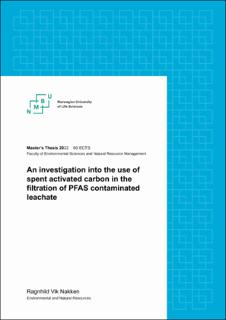| dc.contributor.advisor | Almås, Åsgeir | |
| dc.contributor.advisor | Pearce, Adam | |
| dc.contributor.author | Nakken, Ragnhild Vik | |
| dc.date.accessioned | 2022-09-12T10:07:10Z | |
| dc.date.available | 2022-09-12T10:07:10Z | |
| dc.date.issued | 2022 | |
| dc.identifier.uri | https://hdl.handle.net/11250/3017187 | |
| dc.description.abstract | Per- og polyfluoralkylstoffer (PFAS) er syntetiske organiske kjemikalier som har skadelige effekter på menneskers helse og miljø. Flere forurensa plasser kommer fra tidligere bruk av PFAS-holdig brannslukkningsskum. En betydelig bekymring er, at forurensningen kan spre seg fra forurensede områder til nærliggende vannforekomster og drikkevann. Aktivt karbon (AC) er et av de vanligste bindematerialene (sorbentene) for PFAS-forurenset jord og vann.
Dette studiet undersøker potensialet for brukt AC fra tre forskjellige kilder, om de kan gjenbrukes som en PFAS-sorbent. AC-sorbentene som skal testes er pellets fra luft- og biogassrensing, granulert AC og antrasitt fra avløpsvannbehandling.
Alle AC-prøvene blei først analysert for å finne ut av hvilke forurensinger de hadde fra tidligere bruk. Siden blei en batch-lekking-test uført, for å se hvor lett de hadde for å slippe forurensingene sine ut i vann. Så ble prøvene testet for deres evne til å sorbere PFAS, også ved batch-adsorpsjons test, med varierende mengder av sorbenter.
Det PFAS-kontaminerte sigevannet var dominert av de kortkjedete PFAS komponentene perfluorpentansyre (PFPeA) og perfluorbutansyre (PFBA), blant de 33 kvantifiserte PFASene i sigevannet. Av de ulike sorbentene ga den brukte AC fra luftrenseselskapet CLAIRS det høyeste potensialet for gjenbruk som en PFAS-sorbent, med en samlet effektivitet på 97 % ved bruk av 4 g AC. Absorbenter for biogassrensing og avløpsvannsbehandling viste mindre effektivitet på grunn av DOC og BTEX i sorpsjonsstedene. Avslutningsvis viste luftrensnings sorbenten en større adsorpsjonsevne for PFAS. Imidlertid er det en betydelig mengde svovellekkasje fra AC’en. Ytterligere testing må utføres på andre luftfiltreringsprøver, med søkelys på PFAS-adsorpsjon og svovelutlekking. Det må også testes ytterligere i felt. | en_US |
| dc.description.abstract | Per- and polyfluoroalkyl substances (PFAS) are synthetic organic chemicals that have hazardous effects on human health and the environment. Several pollution hotspots have resulted from the use of PFAS-containing fire-fighting foams. A significant concern is that the contamination can spread from contaminated sites to nearby water bodies and drinking water. Activated carbon (AC) is one of the most common binding materials (sorbents) for PFAScontaminated soil and water.
This study investigated the hypothesis that many spent AC filters are sent to landfills while potentially having unused sorption sites for organic contaminants such as PFAS compounds. The AC types to be tested included pellets from air- and biogas purification, granulated AC, and anthracite from wastewater treatment. All samples were first analysed for their contaminant content, obtained from their previous applications, and then batch leaching tests were conducted to determine the leachability of these contaminants into the water phase. Then the material´s ability to sorb PFAS was investigated, also trough batch adsorption tests, with PFAS-contaminated leachate containing varying concentrations of the sorbents.
The PFAS-contaminated leachate was dominated by the short-chained PFAS perfluoropentanoic acid (PFPeA) and perfluorobutanoic acid (PFBA), among the 33 quantified PFAS compounds. From the various sorbents, the spent AC sample from the air purification company CLAIRS provided the highest potential for reuse as a PFAS sorbent with an overall 97% efficiency using 4 g of AC. Biogas purification and wastewater treatment sorbents showed less efficiency, due to natural organic matter such as humus and BTEX on the sorption sites. In conclusion, the air purification sorbent showed a greater adsorption affinity to PFAS, however, there is still uncertainties around the environmental impacts of the substantial amount of sulphur leakage from these spent AC types. Therefore, further testing needs to be performed on other air filtration samples, not only on the sulphur leaching. It must also be tested in a large-scale field test. | en_US |
| dc.language.iso | eng | en_US |
| dc.publisher | Norwegian University of Life Sciences, Ås | en_US |
| dc.rights | Attribution-NonCommercial-NoDerivatives 4.0 Internasjonal | * |
| dc.rights.uri | http://creativecommons.org/licenses/by-nc-nd/4.0/deed.no | * |
| dc.title | An investigation into the use of spent activated carbon in the filtration of PFAS contaminated leachate | en_US |
| dc.type | Master thesis | en_US |
| dc.description.localcode | M-MINA | en_US |

